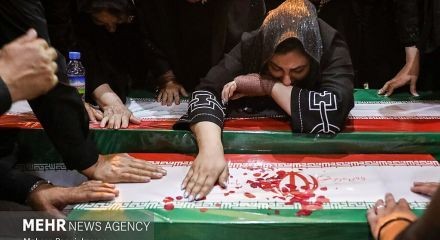21.08.2025

An opposition that serves
Iran’s Reform Front ignores the ongoing war and genocide in Gaza, the threats posed by the US and Israel and effectively buys into western propaganda over the nuclear question, argues Yassamine Mather
Israeli prime minister Benjamin Netanyahu recently affirmed that he “very much” identifies with the idea of “Greater Israel” in an interview, during which he accepted an amulet symbolising the ‘promised land’ from former rightwing Knesset member Sharon Gal. His statement drew immediate condemnation from Arab states, which see it as a direct threat to their sovereignty.
The idea of a “Greater Israel” is not new: it is the ideological backbone of Zionism. In its most extreme form, it demands expansion from Palestine across Lebanon, Jordan, Syria, Iraq, Egypt and Saudi Arabia - an imperialist fantasy masquerading as divine destiny. A narrower version focuses on the territories stolen in 1967: the West Bank, Gaza, the Golan Heights and the Sinai Peninsula. Even though Sinai was returned to Egypt under pressure, Israel clung to the Golan Heights and has relentlessly expanded settlements across the West Bank. Religious Zionists dress this project in biblical passages, but it is nothing more than colonial theft, backed by US weapons and capital. Theodor Herzl’s imperial dream of a Jewish homeland “from the Brook of Egypt to the Euphrates” was never about safety or survival: it was about domination and displacement.
Israel’s borders have always been drawn in blood. After the 1948 Nakba, the 1967 Arab-Israeli war violently expanded the Zionist state. Conquests became a holy cause for nationalist and religious settlers alike. In the 1970s, the so-called Movement for Greater Israel emerged as the political vanguard of expansionism, demanding permanent annexation and mass settlement. Although that movement formally dissolved, its politics became mainstream, permeating Israeli military and political institutions. The project lives on today in the settler militias, the far-right ministers in Netanyahu’s cabinet and the US diplomats who excuse every new war crime.
Since 2022, Netanyahu’s government has escalated its colonial rhetoric to unprecedented levels. Finance minister Bezalel Smotrich openly calls for Israel’s reach to extend to Damascus, denies Palestinian nationhood altogether, and stands proudly in front of maps erasing Jordan. Other ministers push for the full annexation of Gaza, while Israeli soldiers openly wear patches depicting maps of ‘Greater Israel’. These are not harmless symbols - they are blueprints for conquest, apartheid and mass displacement.
New settlements
On the ground, Israel continues to build settlements, particularly in the E1 corridor near east Jerusalem and Ma’ale Adumim. This strategy fragments the West Bank, erodes the prospect of a viable Palestinian state and cements a one-state reality of apartheid. Governments - namely, those of Europe, Canada and Australia - routinely label these settlements as illegal under international law. Yet Israel proceeds, armed with US dollars and protection at the UN, entrenching a Greater Israel future built on Palestinian dispossession.
Donald Trump has bolstered this trajectory. His administrations have constantly legitimised Israel’s theft. His first administration recognised Jerusalem as Israel’s capital, relocated the US embassy, endorsed the legality of West Bank settlements and recognised Israeli sovereignty over the Golan Heights.
In February 2025, Trump went further - proposing to transform Gaza into the “Riviera of the Middle East” by expelling up to two million Palestinians. This was not ‘redevelopment’: it was the language of ethnic cleansing, dressed up as investment. Netanyahu praised the scheme as “remarkable”, proving once again that for Israel, Palestinian life is expendable, so long as expansion continues. Despite outrage from around the world, Israeli leaders embraced the idea, certain of their US shield.
That is why repetition of Netanyahu’s call for “complete occupation” of Gaza is not rhetorical exaggeration - it is the culmination of decades of policy. From the 1967 war and beyond, Israel has sought to crush Gaza. Today, settler movements demand annexation and colonisation, branding it the “unfinished business” of Zionism. As Gadi Algazi reminds us, colonial wars do not begin or end with declarations:
From historian Henk Wesseling, who specialises in Dutch colonialism, I learned that colonial wars have no clear beginning or end. I’m quoting from memory, so I may be adding a bit of my own. They don’t start with declarations of war, nor do they end with celebratory ceremonies. Don’t think of them as stories with clear beginnings and ends. Think of them as continual processes in which people are killed and lose their homes, even during ‘peace’. Many continue to be killed, wounded and displaced after ‘the war’ ends.
A colonial war is a violent social process that cannot be classified as either ‘war’ or ‘peace’ in the traditional sense. Wars can be waged with bulldozers, and settlements can be carried out with tanks. There can be pauses, but the ongoing process can radically escalate at any moment. These wars have partial interruptions, but that does not mean they end. When they flare up, those who aren’t usually affected wake up and discover that the war has been ongoing all along.1
Netanyahu’s rhetoric envisages war without end. If Hamas is destroyed, Islamic Jihad emerges; if it is eliminated, resistance continues through guerrilla tactics, stones or knives. Each act of defiance renews the justification for further occupation. Settlers, rebranded as ‘residents’, will live under constant threat, perpetuating the cycle of violence. For Palestinians, this signals dispossession and annihilation; for Israelis, it means generations bound to a war machine.
Regional tensions
Meanwhile, tensions with Iran escalate. Two months after Israel’s 12-day war, Iran grapples with an economic crisis brought about by US sanctions and the threat of renewed UN sanctions through the ‘snapback mechanism’ of the Joint Comprehensive Plan of Action (nuclear deal). Already isolated, Iran’s trade relies on covert channels and limited partners, such as China and Russia. Last week, Netanyahu attempted to appeal directly to the Iranian people, but his efforts often totally misfire. Recently, he displayed a book by Iranian dissident Akbar Ganji during a speech, apparently unaware that Ganji has long denounced Israel. The stunt underscored the disconnect between Netanyahu’s messaging and regional realities.
The Reform Front coalition of 27 activist groups in Iran issued a statement outlining the serious risks and threats facing the country, declared that establishing national reconciliation and abandoning hostility at home and abroad is the only path to saving the country and a golden opportunity for change and a return to the people. To exit the crisis and prevent activation of the snapback mechanism, the Reform Front called for comprehensive and direct negotiations with the US, expressed readiness for the voluntary suspension of uranium enrichment and acceptance of International Atomic Energy Agency oversight in exchange for the complete lifting of sanctions.
At the same time, this current urged all national political forces that support “peaceful and non-violent reform, along with all decision-making institutions committed to the rights of the people, to abandon artificial and fruitless divisions and rally around national interests”.
According to the statement,
The 12-day war … showed that Iran is determined and capable of defending its territorial integrity. But it also revealed that continuing on this path - without rebuilding national trust and opening constructive engagement with the world - will impose heavy human, financial and psychological costs on the nation …
Under these circumstances, the threat of the European Troika activating the ‘snapback mechanism’ is very real and imminent. The return of Iran’s nuclear file to Chapter VII of the UN Charter would restore UN sanctions and bring about a deeper stagnation than the consequences of the recent war. This return would also provide international legitimacy for a future war against Iran under the label of a ‘threat to peace’ …
Today, at this historic crossroads, three paths lie before the people and the state:
A. Continuing the current situation, with a fragile ceasefire and an uncertain future.
B. Repeating the pattern of the past 22 years - tactical negotiations to buy time without addressing the roots of the crisis.
C. A courageous choice: national reconciliation and abandoning hostility at home and abroad, to reform governance and return to the principle of popular sovereignty …
The Reform Front of Iran, based on the strategy of reform from within, considers national reconciliation and its results to be the only way to save the country and a golden opportunity for change and return to the people. Without deep structural reforms, however, reconciliation and general amnesty would become nothing more than a political show.2
From within
The Reform Front calls for national reconciliation and structural change through liberalisation (amnesty, freeing prisoners, ending repression), direct talks with the US and normalisation of relations, voluntary limits on nuclear enrichment under IAEA oversight in exchange for lifting sanctions, removing the military from politics and the economy, reducing the state’s security-heavy approach, and freeing the economy from oligarchic control to ensure equal opportunities.
Not that we should have expected much from these groups, but the statement and the ‘road map’ on offer suffer from a striking detachment from present realities. Focusing narrowly on internal reforms and nuclear negotiations, the statement ignores the ongoing war and genocide in Gaza, the threats posed by the US and Israel, and the deeply entrenched project of ‘Greater Israel’ that openly aims to erase Palestinian nationhood and redraw regional borders.
In framing Iran’s negotiations with the US and the suspension of nuclear enrichment as the central path to “salvation”, the Reform Front effectively buys into western propaganda that portrays Iran’s crisis as primarily nuclear, rather than geopolitical and colonial. This reduces the conflict to a technical dispute over uranium, while sidelining Israel’s expansionism, its military aggression and its occupation policies that are the true sources of instability in the region.
By ignoring these realities, such proposals are disconnected from the urgent struggles facing both Iran and the broader Middle East.
